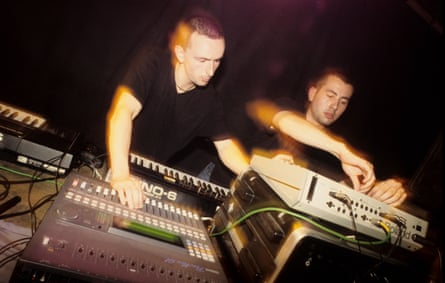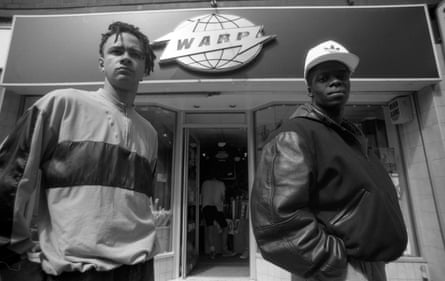Bleep it out! The bowel-quaking dance music of late-80s Yorkshire
Books and compilations are reanimating the overlooked sound of bleep: a speaker-smashing strain of DIY techno born out of breakdance rivalries and heavy industry
original article here – https://www.theguardian.com/music/2023/may/03/bleep-dance-music-80s-yorkshire
In 1989, George Evelyn was driving in a stream of shimmering headlights, in convoy, to a rave in a slaughterhouse in Blackburn with about 10,000 others. He recalls thinking: “This must have been what the 60s were like – I was convinced we were having a revolution.”
A few hours later, Evelyn was outside getting some air when he heard familiar bleeps and beats echoing through the evening air as screams of delight rang out. “We went in and, oh my God,” he recalls. “That was the first time I’ve seen shit like that.” They were playing his debut track as Nightmares on Wax, Dextrous. “It was pure euphoria and excitement,” he says. “But I was also scared – because we just existed in a Leeds bubble.”
It was one of many instances between 1988 and 1991 where bleep, a sub-style of techno often loaded with knee-shaking sub bass, erupted to rearrange dancers’ heads and innards. But the genre has often been skipped over since, says Matt Anniss, author of Join the Future: Bleep Techno and the Birth of British Bass Music. “It’s been criminally overlooked,” he says. “There was this big, gaping hole in the history of UK dance music during the period where bleep should be. I wanted to correct that.” Join the Future has been rereleased as an expanded edition this month, there’s an accompanying compilation under the same name, and also just out is another compilation: Bleeps, Breaks + Bass Volume 2.
Bleep is part of a clear lineage: all-dayer soul and jazz-funk dos, Black British house parties called blues or shebeens, and the reggae sound system culturethat inspired both. Yet it is also a series of big-bang moments where dazzling new sonic languages were forged. A Guy Called Gerald’s Voodoo Ray will for ever, and correctly, be considered the blasting cap for the sound, but another 1988 tune released within a few months of it was also explosive: Unique 3’s The Theme.
Sketched out in a terrace house in Bradford, literally making the walls shake, the track was later hand-delivered to record shops, and a wave of admiration, popped heads and rumbled guts followed. “The Theme was immense,” says Winston Hazel, who in Sheffield was a buyer for FON Records, DJ at Jive Turkey and soon to be making music in Forgemasters. “People would sing the bleep riff in unison, like a football chant. It was a tribal call to play that fucking track again.”
“Voodoo Ray and The Theme fit in with the Chicago and Detroit records we were playing,” says Richard Barratt, AKA Parrot, DJ at Jive Turkey who formed Sweet Exorcist with Cabaret Voltaire’s Richard H Kirk and released the bleep anthem Testone. “But they sounded like they had been made by people like us. It heralded a sound with a distinctively northern accent.”
Gez Varley, one half of the original LFO lineup, was in a Leeds record shop when The Theme landed. “We were blown away,” he says. “It was like, right, we’ve got to get something out now. It was local lads that made this great record. Before that, I’d never believe that was something one of us could do.” Such was the conviction around The Theme, Unique 3 even went to a rival dance crew’s night in Leeds and marched through a packed dancefloor to hand the DJ a copy to play. The DJ was Kevin Harper, then one-half of Nightmares on Wax, and despite playing the B-side by mistake, it went off so much it got played three times in a row.

This moment of scene harmony was rare, because a leftover attitude from the culture of kids who all grew up competing in break dancing crews meant things were tribal. By 1989, the reputation that Dextrous was brewing around town even led Evelyn to be confronted by a rival crew in a kebab shop, proclaiming “there’s no way that’s your fucking tune”. Evelyn laughs retelling the story, adding, “best compliment you could have.”
Murmurs were happening about a new label in Sheffield, and the first act they wanted for what would become Warp Records – later home to Aphex Twin, Autechre and so many more – was Unique 3, but they signed to Virgin. Rob Gordon, Warp co-founder and a supremely talented and important producer and engineer in the bleep story, remixed The Theme for its Virgin rerelease as his “bass statement” but no mastering engineers would touch it. One did, Geoff Pesche, but in order to fully capture the sheer depth of sub-bass on the record, he crawled under the mixing desk to remove its limiters. Letters of complaint flooded to Virgin, as ill-prepared speaker systems were blown and destroyed across the UK.
By now, Hazel, along with Gordon and Sean Maher, were making music as Forgemasters. While sound system culture and reggae was crucial to much of bleep and bass’s foundations, along with techno, house and electro, Sheffield had another unique element. “The Sheffield clang,” Hazel explains. “Our sounds bore a striking resemblance to heavy industry – in particular the 15-ton drop hammers which could operate seven days a week, in 16-hour shifts. These created deep sonic ricochets that bounced off Sheffield’s hills.” This thundering clang literally echoed through Hazel’s dreams. “The sound became a continuous heartbeat while I slept; this subconscious hypnotic rhythm stayed with me and began to show up in the music.”

The resulting Track With No Name was another landmark moment. Its flurry of rhythmic drum patterns programmed on Gordon’s 909 machine, along with a hooky synth line and a chopped down sine wave for a bassline, resulted in a raw yet immaculate piece of South Yorkshire techno. It was Warp’s first release, kickstarting a classic run of dance tracks from Nightmares on Wax, Sweet Exorcist, LFO, Tricky Disco and Tuff Little Unit.
Evelyn calls this chronology a “call and response” approach between acts, each wanting to outdo one another. “We all competed against one another as breakdancers in our teens,” he says. “So it was a continuation. We didn’t receive a track as a club anthem, we received it as: shit man, we’ve got to do something.”
Not everyone shares Evelyn’s belief in there being a fierce rivalry but regardless, a stream of gamechanging music was being produced. Testone remains perhaps the most literal example of bleep techno, by being constructed from non-musical tones used to test audio equipment, resulting in a startling record that sounds alien yet euphoric. LFO’s behemoth track LFO, though, propelled this music being made in crumbling industrial spaces, bedrooms and makeshift studios into another realm.
So insular was LFO’s world that they only ever envisioned making music for one place. “It was all about getting played at the illegal parties in Chapeltown,” Varley says. “We started putting in subsonic bass just to blow the reggae kids away at the local party. On LFO, we used a kids toy, the speak and spell machine, to say “LFO” so they knew it was us – like a breakdance crew, you’re showing off.”
However, that move proved ingenious and ended up being a calling card left across the UK. Crowds would rush DJ booths to enquire about it and it made going into record shops to ask, “You got that track that says ‘LFO’?” an easy question to answer. It shifted hundreds of thousands of copies and went to No 12 in the charts. “We went from being nothing to being played on Top of the Pops,” recalls Varley.
Much like Unique 3, who were also bothering the charts, LFO exploded in more ways than one: once again blowing club systems or shattering racks of wine glasses in bars. Combined with the rising use of ecstasy, this music was sending people into a frenzy. “But it was the tiny speakers that made me smile,” says Barratt. “When records started getting in the charts, most people listened on little transistor radios that didn’t pick up the low frequencies. LFO would get to the sub-bass dropdown and there’d just be silence.”

This takeoff took Evelyn by surprise. “We had fuck all but we made shit good out of absolutely nothing,” he says. “What was so beautiful and naive about it was that the benchmark was another DJ playing your song. That was the absolute – nothing beyond that. That’s where we were all coming from. There was never talk of a career.” Such was Warp’s breakout success that by 1990, this tiny Sheffield operation that began in a bedroom with £2,000 from the Enterprise Allowance Scheme, was behind 2% of all record sales in the country.
Bleep is often synonymous with Sheffield because of Warp, but it’s wider than that. Leeds’s Ital Rockers crafted one of the genre’s biggest tunes in Ital’s Anthem, released on Bassic Records, but also the parties they threw via their own soundsystem were pivotal. “In Leeds, those parties were just as important as the Haçienda to Manchester,” Varley says. Network Records from Birmingham was also vital, releasing the likes of Forgemasters, XON and Rhythmatic.
For Sally Rodgers, who’s on the Bleeps, Breaks + Bass compilation as A Man Called Adam, it captured a beautiful moment. “It was this brief little time when really DIY stuff could move into the mainstream, democratised by access to new technology,” she says. “Before things became so much bigger and more compartmentalised. It was a real golden moment.”

Such was the lightning-fast trajectory of dance music in the early 1990s, the scene evolved and moved on, but Anniss feels bleep has infiltrated so much since, “from bassline and dubstep to grime,” he says. “Plus, the bass-heavy techno promoted by labels like Livity Sound, Timedance and Trule.”
Over 30 years on, Varley still can’t shake the endless reverberations of LFO. “I’m never gonna get away from it,” he laughs. “When I die it’ll be played at my funeral … although I’m not sure the church speakers could handle it.”
Join the Future is out now on Velocity Press. Bleeps, Breaks + Bass Volume 2 is out now on Musique Pour La Danse.
